Yucatan Tourism Information (for Mayan Ruins)
.jpg)
The Yucatan Peninsula is quite different from the rest of Mexico. A distinct change is noticeable in the landscape, people and architecture when crossing into the remoteness of the land. The atmosphere is more relaxed and tranquil and the legacy of an ancient people is evident in the scattering of ruins within the encroaching jungle. It is an area famed for its white sand beaches, magnificent offshore coral reefs and diving opportunities on the Caribbean coast, as well as for the region's splendid ruins: the extraordinary Mayan temples and ceremonial centres of an ancient kingdom.
The Yucatan Peninsula is very hot year-round. The are, two distinguishable seasons , wet season and dry season. The wet season usually starts in June and ends in October, making the dry season last from November to May. However, temperatures are always high, and it's only thanks to the thunderstorms and rainfalls that it feels more comfortable.
The weather in the dry season is much more desirable and pleasant for most tourists. The dry season is still hot, but much more tolerable than the wet season. Although the average temperatures throughout the year don't vary by much. It usually gets about 25°C in January and 35°C in July. The humidity in the summer months makes it feel excruciatingly hot most days, especially to those who aren't used to a humid climate. In the wet summer, it actually rains most days towards the afternoon and evening.
This rain comes in heavy, short spurts. There is also a strong threat of hurricanes during the wet season (which is why the wet season is often referred to as hurricane season), which have been getting stronger over the past few years.
❗Attention: If the lower prices of the summer attract you enough, make sure you completely understand your risks weather-wise before you plan your trip.
Getting to the area can be done easily by plane arriving at Merida's, Manuel Crescencio Rejón International Airport (MID). The airport is located 8 Km from Merida. Authorised taxis connect the airport to the city. At present, taxis are the only way of getting from the airport to the city centre. Uber drivers are not allowed to pick up from the airport, and if they are caught by the federal police they might lose their vehicle with a fine. However, many drivers still offer to pick up visitors on the APP. On the return to the airport, it's easier, with a bus service run by ADO which is a good and cheap way to get back, or you can go by Uber without any problem.
The airport is located 8 Km from Merida. Authorised taxis connect the airport to the city. At present, taxis are the only way of getting from the airport to the city centre. Uber drivers are not allowed to pick up from the airport, and if they are caught by the federal police they might lose their vehicle with a fine. However, many drivers still offer to pick up visitors on the APP. On the return to the airport, it's easier, with a bus service run by ADO which is a good and cheap way to get back, or you can go by Uber without any problem.
Once in Merida, you can continue your trip to other cities in the region by bus (ADO Company) or drive. In Merida there are two different bus stations, one where only ADO busses operate and another the other is a bigger bus station (currently being refurbished) where services are offered by the other companies. Like Oriente, another bus company (owned by ADO) but offering second class service, being cheaper and sometimes longer rides.
Alternatively you can also travel to Yucatan from other cities in Mexico by bus, but the journey can take 10 to 12 hours easily.
The Yucatan Peninsula, is serviced by regular bus services that connect Merida to Valladolid, Cancun and the Caribbean coast along Highway 180, via Chichen Itza. Taxis are the preferred way to get around most of the resort areas and can also be hired to visit nearby sites, although several tours are offered to the main sites of interest on the peninsula or the islands. Within the area, it's also possible to travel to Quintana Roo by bus, famous for Cancun, Tulum, Playa del Carmen and the islands of Isla Mujeres and Cozumel. For more information for this part of Mexico visit our info page about Quintana Roo.
The local transport in the area is mainly operated by busses (colectivos) or vans which display the destinations they travel by signs on the front window. They often wait till the service is full, they run an infrequent timetable and can be hot inside at times. They are not the best way to travel, as for comfort, but the price is cheap if you are up for the adventure.

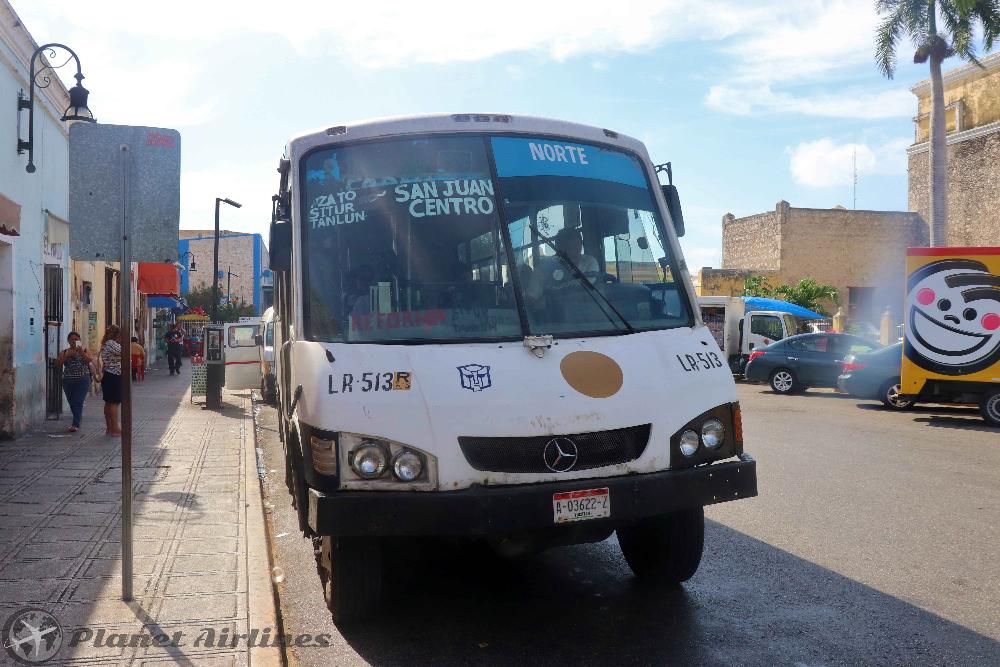
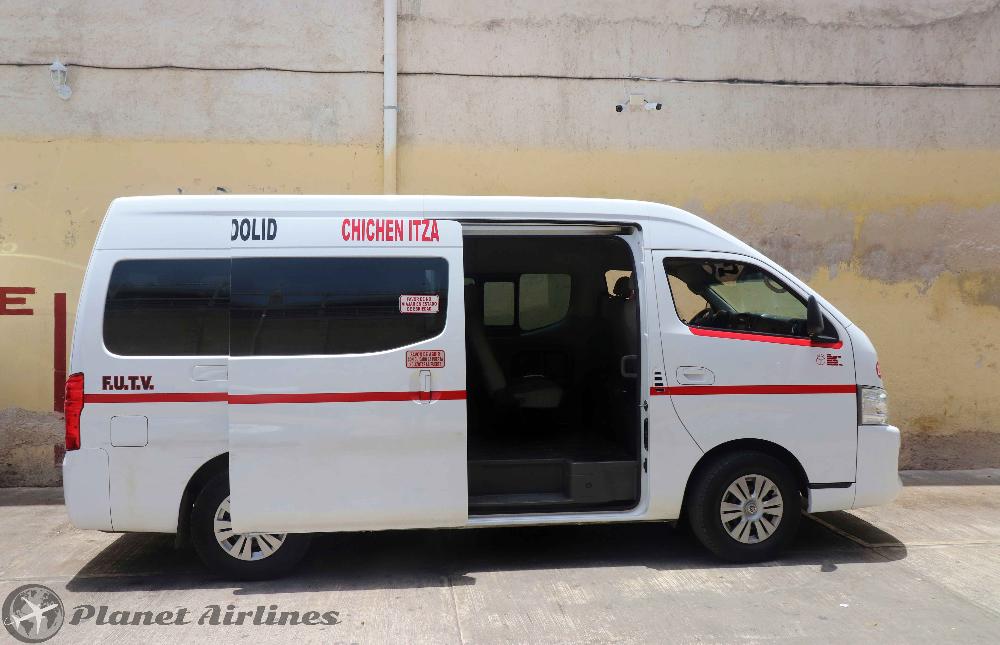
The peninsula is an area of great diversity. Visitors can explore tropical jungles and rainforest, flat and hot countryside dotted with Mayan villages, a superb coastline with popular resorts and islands, numerous archaeological sites, and colonial towns. Once distant and inaccessible, tourism has made great advances into the Yucatan Peninsula, especially around the major places of interest, like the Mayan sites of Chichen Itza and Uxmal (see next tabs). The traditions, religious beliefs and ancient customs of today's Mayan culture are still a natural part of the Yucatan's character and appeal, although the culture has become somewhat commercialised in certain areas.
When visiting the area, staying in the cities of Merida or Valladolid are the best locations to access most of the places of interest. However, many people also choose to stay in Cancun, the popular holiday resort beach area, however is much further away if you plan to see the historical sites, but prefer to stay near the beach and the islands.
In the below section you will find more detailed information about the main sites to see whilst you are in the Yucatan Peninsula:
- Merida: is a city posing as a town, nicknamed "Ciudad Blanca", as in the past it was only allowed for white people to live in the area. Today, it's a unique place open to all backgrounds, an urban area whose colonial homes, some restored, others faded, with hidden courtyards and tropical gardens give the city a smaller scale. Life here is relaxed, due to the Caribbean climate, slowing daily pace to a laid-back manner. With its many hotels and restaurants, cultural attractions and lively shopping scene, Merida is a major tourism spot in the Yucatan and an ideal base for exploring the nearby Mayan ruins of Uxmal (see next tabs) and natural wonders of the area.
Things to do and see in Merida are the main square, (Plaza Grande) centre of the city, where you will find the cathedral, and several cultural events like the sound and light show which projects on the cathedral every Saturday at 21.00. Montejo Museum, the local government's Palace, tourism information office and the bus tour departure point.
Other places of interest include the Paseo de Montejo with its colonial buildings, mansions and wide avenue; San Juan Park (departure point for many vans and local busses); Santa Lucia Park (with big famous chairs) and Santa Ana Park with nearby restaurants and terraces. with nearby restaurants and terraces.
✔️Tip: Visit the Mayan World Museum of Mérida: If you are feeling intrigued by the Mayan culture and want to learn from it further, then this museum exhibits a great collection of more than 1100 remarkably well-preserved artifacts, Mayan culture from its formation, growth, hispanic influence and heritage during the years. The museum can take up to 2 hours to explore and also projects a free light and sound show on it's wall outside at night. It's located 12 Km from the downtown and can be reached by busses running along street "Calle 60". Cost of the entrance is 150 Pesos for visitors.


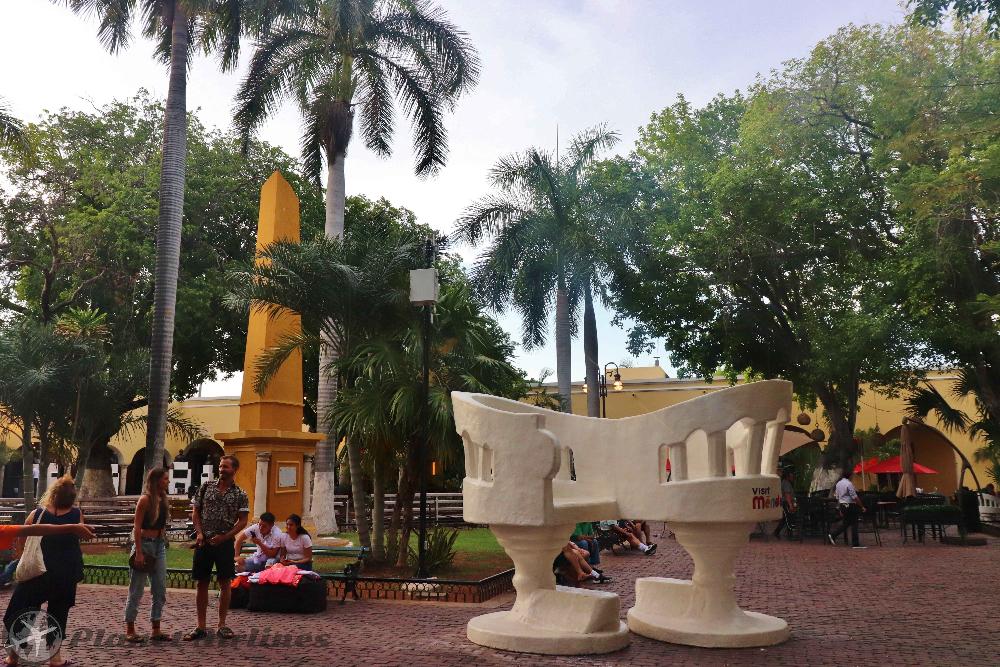

- Valladolid: is without any doubt, one of Mexico’s most magical and beautiful towns. It is also one of the most relaxed, friendliest and safest towns of Mexico. Whether it’s the joyful way of life or the colonial architecture, there is always something eye-catching about Valladolid. Conveniently located within a 2.15 hours from either Merida or Cancun, it's an ideal place to visit for a tour or stay in Valladolid, making it your base to see many of the great highlights around it, like the Chichen Itza (see next tabs) or Cenotes (natural sinkholes).
The town itself is pretty small, but you can visit the main square of Francisco Canton Rosado Park, where the city centre is located. Here you also have interesting buildings like the Iglesia de San Servacio, Casa de los Venados and Plaza Casa De La Cultura Valladolid (Cultural open House). In walking distance you can stroll along the street of "Calzada de los Frailes" which leads you to the old monastery of San Bernardino de Siena, now a convent. Every day it displays a projection of light and narrated history at 21.00, to learn more about the history of events that took place in Valladolid from the pre-hispanic days to today. It's free to attend and watch!
✔️Tip: Know the local history by joining a free walking tour in valladolid. Tours depart every day at 10.00 am 17.00 or 19.00 pm, from the main park in the centre of the town and are given by knowledgeable local guides. It's a great way to learn first hand all the events which took place and understand the heritage from the mayas and the spanish.
After a long day of walking and discovering the Mayan ruins of Chichen Itza, the best thing you can do is swim in the local Cenote Zaci, only 5 Min walk from the main square of the town. The water there is always cool and fresh. One can relax observing the people swimming and diving from different heights or you can swim in the natural hole surrounded by harmless fish! it costs only 30 pesos to enter.


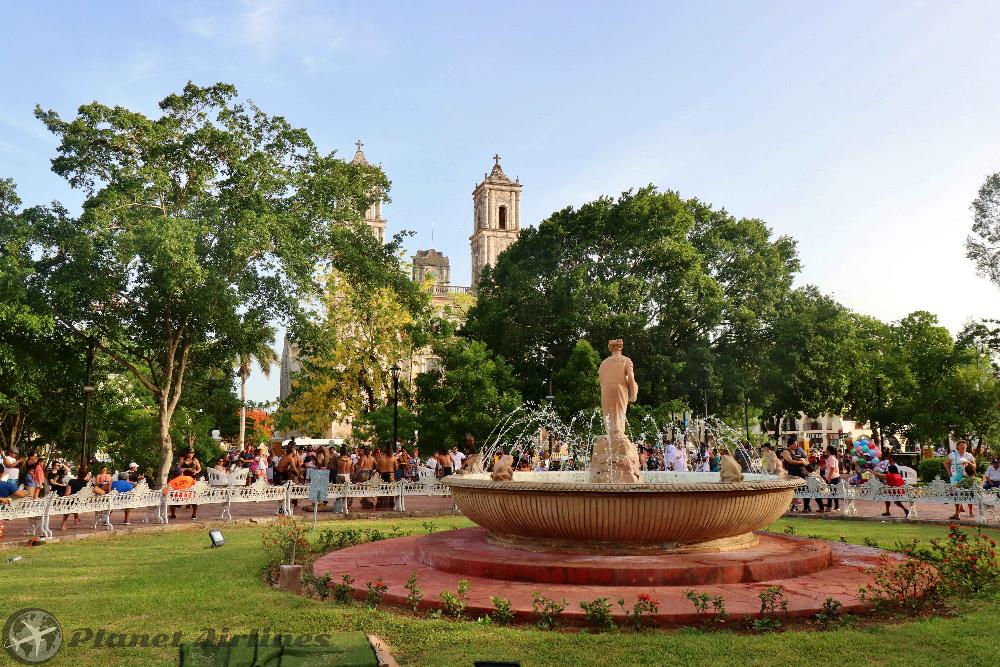



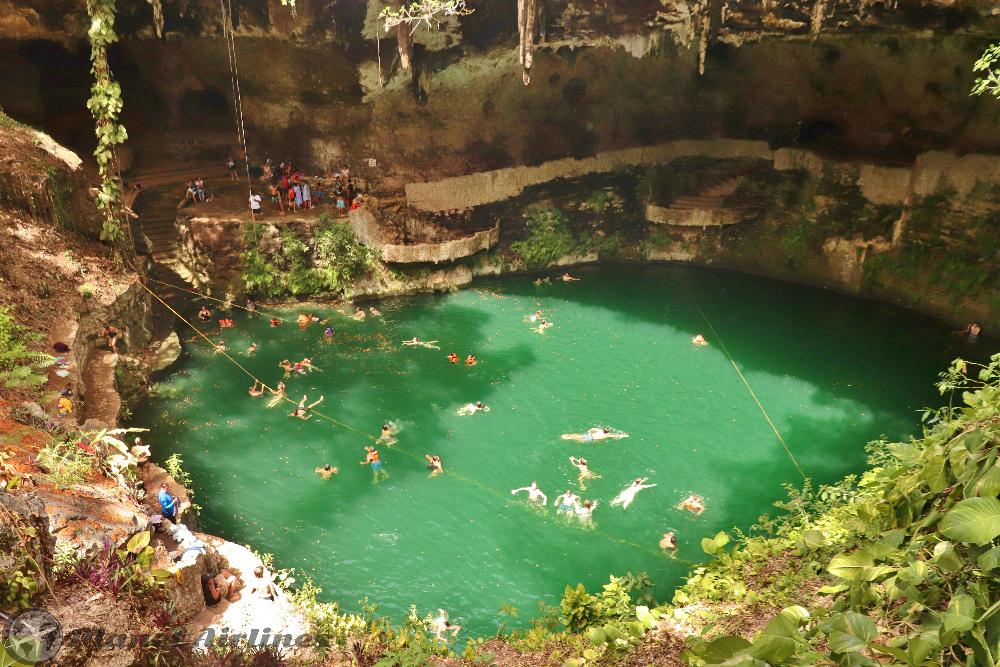
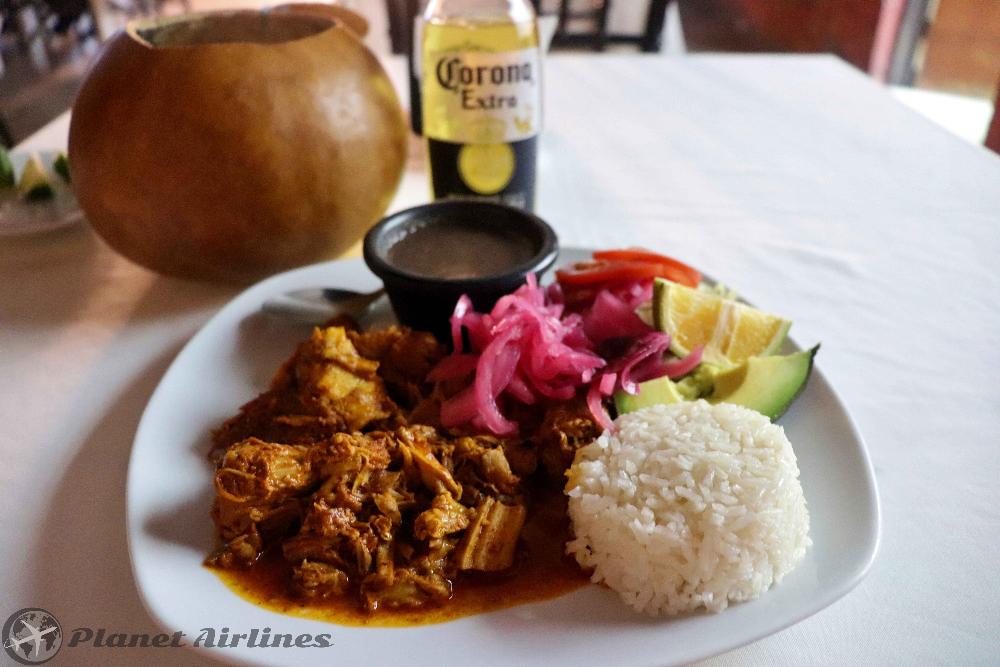
✔️Tip: Try Cochinita pibil (also puerco pibil) is a traditional Mexican slow-roasted pork dish from the Yucatán Peninsula.Preparation involves marinating the meat in strongly acidic citrus juice, seasoning it with annatto seed which leads to a vivid burnt orange color, and roasting the meat while it is wrapped in banana leaf. It's delicious accompanied with a Mexican beer to cool down the spices!
- Nearby is Ek Balam, (meaning Star Jaguar) located less than 30 minutes from Valladolid, the ruins of Ek Balam (Black Star in Mayan) are very unique in the sense that they feature what seems to be stucco carvings of Mayan Winged Angels in the main pyramid of the area.
- Cenote Ik Kil: This is one of the most famous Cenotes, (Natural water holes). It is also one of the most photographed cenotes in the Yucatan Peninsula of Mexico. It is well liked because it looks like some deep tropical hidden paradise. There are vines and roots that hang down into the water and verdant plants around the lip of the entrance to this cenote. However be advised that Cenote Ik Kil is a major stop for many bus tours to Chichen Itza. Thousand of people daily visit Chichen Itza Mayan ruins and many people do so by bus tours. So if you want to enjoy this incredible site, it's best you do it early in the morning to be able not to clash with many tour busses at the spot. Entry to the cenotes cost 80 Pesos. You can also combine a meal or even a night accommodation, as the area has a hotel on the premises.
Getting to the cenote Ik Kil is easy by van from Valladolid. It costs 35 pesos. Take the van which leaves next to the ADO bus station at Valladolid. Tell the driver you want to get off at cenote Ik Kil. To return just wait on the main road for the white and red van and flag it down to make it stop.
Chichen Itza was a Mayan city on the Yucatan, considered the most important site in Mexico by size and importance. Although it’s an popular tourist attraction, Chichen Itza also remains an active archaeological site. New discoveries are still being unearthed in the area, providing even more insight into the culture and accomplishments of the Mayan people, who ruled much of present-day Mexico and Central America prior to the arrival of European colonists. Chichen Itza was named a UNESCO World Heritage Site in 1988 and was included as the 7th wonder of the modern world in 2007.
Chichen Itza is located about 42 Km from Valladolid, 120 Km from Merida city and 200 Km from Cancun. The name Chichen Itza is a Mayan language term for “at the mouth of the well of the Itza” or "The wizards of the water". The Itza were an ethnic group of Mayans who had risen to power in the northern part of the Yucatan peninsula, where the city is located. Historic accounts differ as to when Chichen Itza was built and ultimately developed into a centre of political and economic power. Some accounts place the establishment of the city in the early 400s A.D., while others suggest construction started a few years later, in the middle part of the fifth century.
Remarkably, given the relatively simple technology available at the time, Chichen Itza was built in an area of rough terrain that was levelled in order to accommodate larger structures, including, most notably, El Castillo (“the castle”), a pyramid structure that, thanks to restoration efforts still stands today. Another larger structure on the site, Las Monjas, which served as a government building, was also built on levelled terrain.
At its height, it is believed that as many as 50,000 people lived around the city. Although the fall of Mayan civilization is widely attributed to the arrival of Christopher Columbus in 1492, and the European colonialists that followed the famous explorer, Chichen Itza may well have lost its place as an important city in the region long before then, political and economic activities of the city had shifted to Mayapan, a newer community built to the south and west of Chichen Itza, by the mid-1200s.
Today, a number of important structures of the original city remain standing, some thanks to restoration efforts on the part of the Mexican government. Among them:
- El Castillo: Also known as the Temple of Kukulkan. This pyramid-shaped structure stands close to 100 feet high.
- The Great Ball Court: Just to the northwest of El Castillo, this structure was used for the "El juego de la Pelota" or ball game. It was not a sport as u such as many may think. In fact it was a game they played with ritual believes as a way to ask for fertility or rains for their agriculture.
- The North Temple: Also called the Temple of the Bearded Man, this small building is adjacent to the Great Ball Court and features a carving on its inner walls, with the central figure of a man with a carving under his chin that resembles facial hair.
- Sacbe Number One: One of the paved streets of the city that extends nearly 900 feet.
- Temple of the Warriors: Another large, stepped pyramid.
- Group of a Thousand Columns: A series of exposed columns that are believed to have supported a large roof system.
- El Mercado: A square structure at the southern end of the Temple of the Warriors that archaeologists believe served as the city’s marketplace.
- El Osario: Another step-pyramid structure with a temple at its peak.
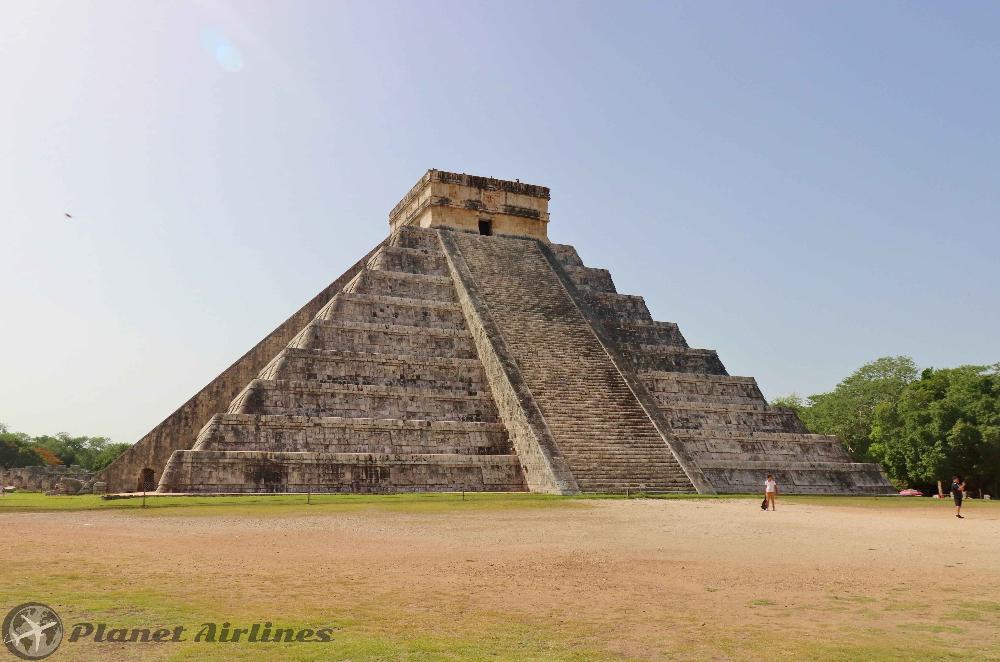

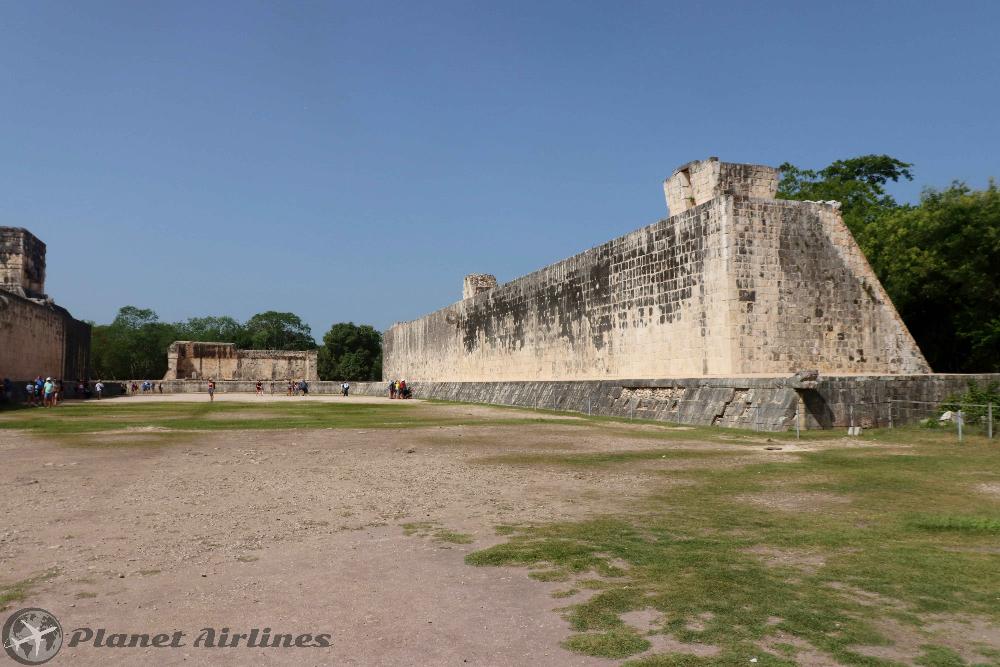





✔️Tip: Today, some 2 million tourists visit Chichen Itza annually to explore its architectural wonders and gain further insight into Mayan history and culture. To visit, its recommend to arrive early in the morning as to avoid the mass of tourists and groups that arrive at from 10.30 from all over the Yucatan and Quintana Roo.
Getting to the site: Local colectivos (shared 12-passenger vans) from Valladolid to Chichen Itza can be found on Calle 46, in a small parking lot located behind the ADO bus terminal. The vans leave every 30 minutes or so between 7 AM and 6 PM. The one-way fare costs 35 Pesos and the journey takes approximately 45 minutes. Alternatively you can travel by ADO bus, for 85-100 MXN one way, in comfortable busses. When you return, taking the vans, they stop at the big tree roundabout located near to the entrance of the Chichen Itza. The access to Chichen Itza costs 481 Pesos and you can pay with card also.
Located 84 km from Merica city, Uxmal was an important Maya city which flourished between the 6th and 10th centuries CE. The city, following an extensive restoration programme, is the best preserved of all Maya sites, and it possesses some of the most outstanding examples of ancient classic Mayan architecture anywhere.
Within the ruins you can see the following major sights:
- Pyramid of the Fortuneteller: A the three-level pyramid, which has two distinct profiles which leads scholars to believe the structure had two separate building phases, beginning in the 6th century CE and ending in the 10th century CE.
- Nunnery Quadrangle: The building was built in the late 9th century CE with various additions being made in subsequent decades. A large courtyard enclosed by four separate rectangular buildings is accessed via a monumental staircase on the south side which leads up to a large corbel arch entrance.
- House of the Governor: This 24-room building was constructed in the 10th century CE to commemorate the reign of Lord Chahk, the last great ruler of Uxmal,
- House of the Pigeons: Located behind to the right of the House of the Governor and the Great Pyramid, this buildings gets its name from the intricate façade with its many small apertures which resembles a dovecote.
Getting to the site, can be done by tours from Merida. But you can also go there by public transport from the main Bus Terminal in Merida, taking SUR busses which depart every 2.5 hours. The best time to leave is taking the 10.40am bus, taking 90 min to reach Uxmal. The return trips are at 15.19, 17.49 or 20.19 the last one. It costs 76 Pesos one way, and its best to buy the open return ticket from departure point in Merida. Note that busses are not always very punctual on this route. Once you arrive, the price of getting into the ruins is 413 Pesos. The highlights of the area include:



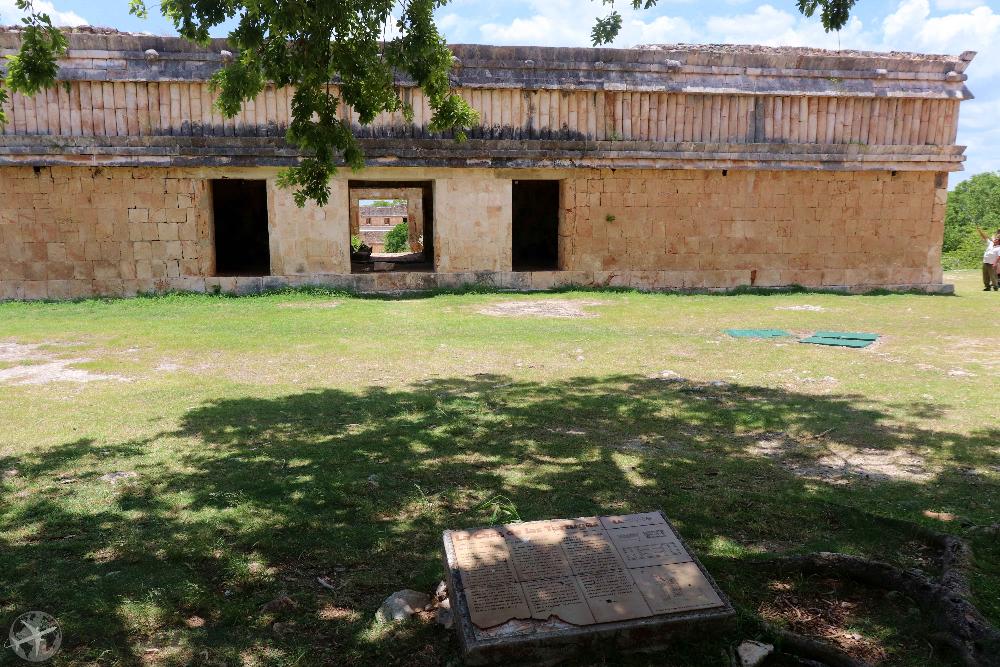
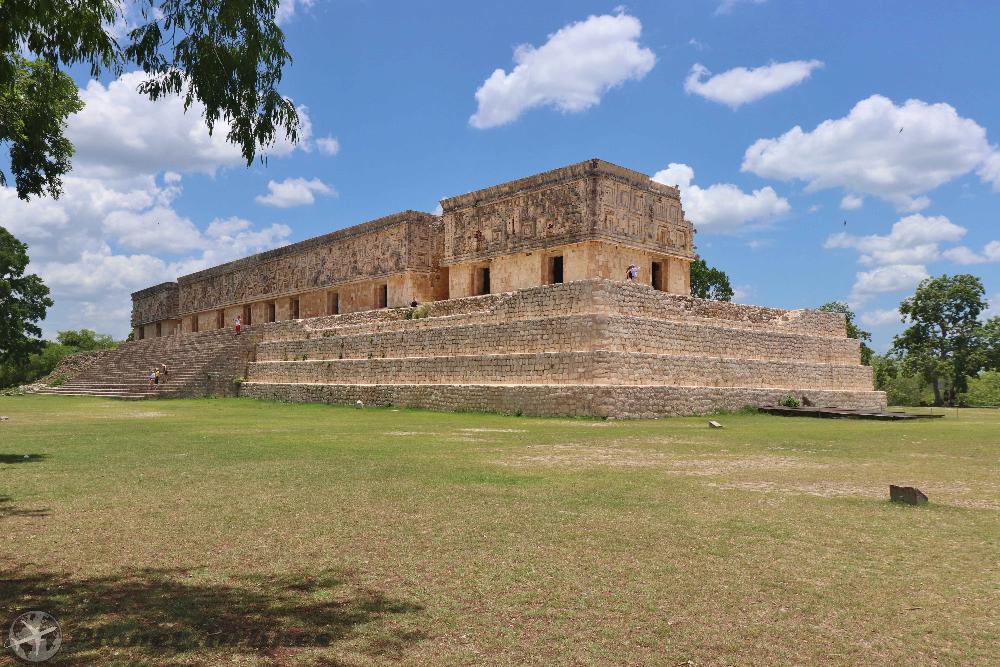
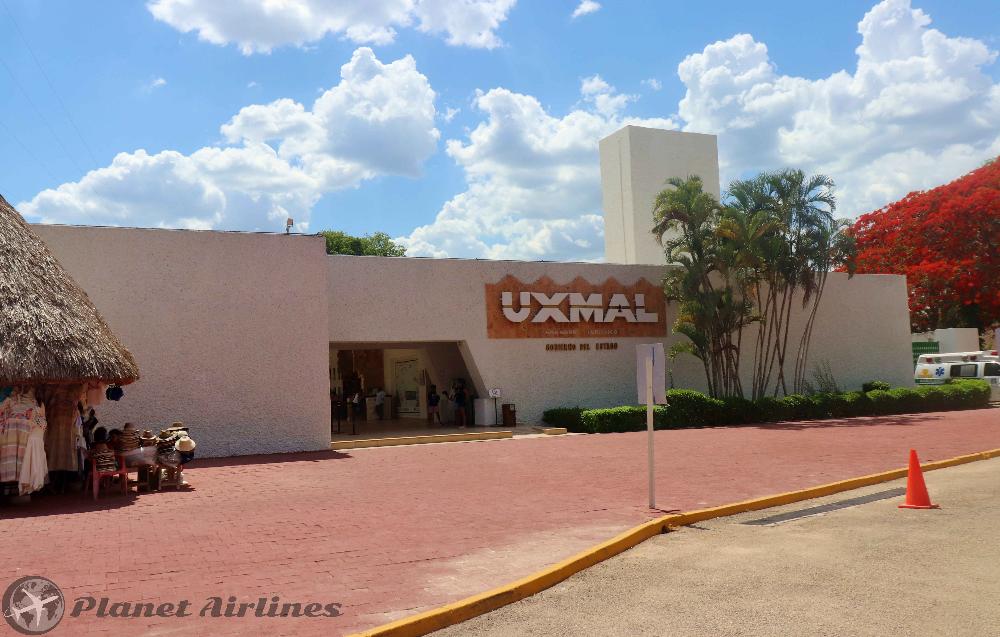
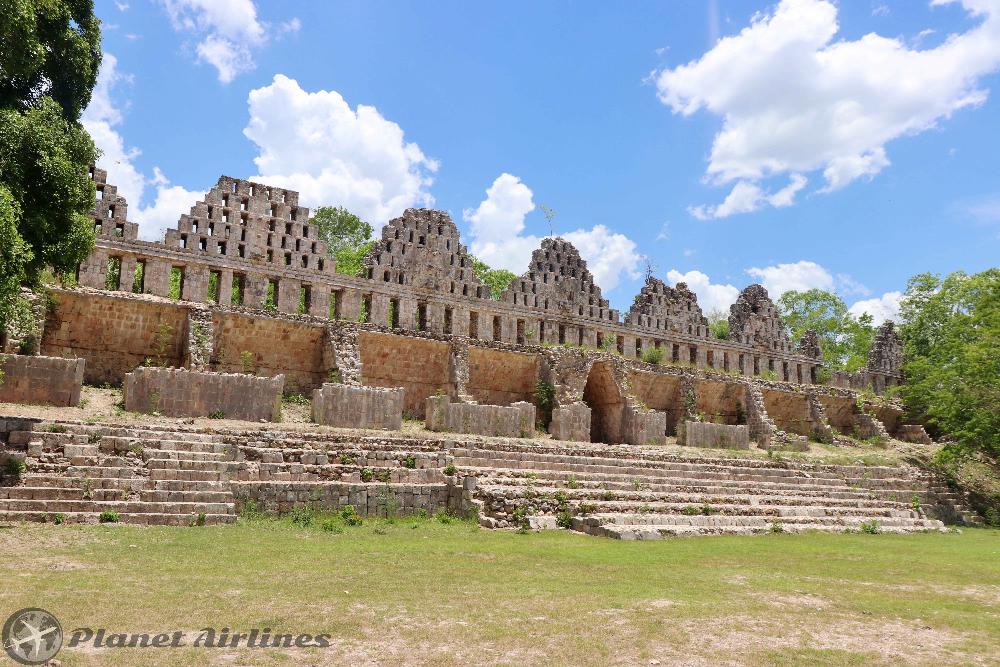

Known as the yellow city and the city of the three cultures, this is an even smaller magical town than Valladolid. Located two hours away from Valladolid or 45 Min from Merida you can easily explore Izamal in a couple of hours. The first thing that any visitor notices is that the town is painted yellow! All the colonial buildings, the market, the huge convent, everything! The next things that stand out are the cobblestone streets and the iron lamp posts that give the town a tranquil ambiance. To visit Izamal is to visit a town that is alive with three cultures; the ancient Maya, the colonial, and the present day bustling Izamal. The town is a monument of color, history and pride that can be felt in its streets and buildings.
Izamal may be the oldest city in Yucatán, conquered by the Spaniards like all the rest, the monks in their eagerness to convert the Indians to Catholicism gave the city its religious distinction. To this day, Izamal locals are very devoted to the Immaculate Virgin. The most important thing to see is the Franciscan convent that was built over one of the Mayan pyramids. Other things to see whilst walking around is the Government Palace, Kinich Kakmó Maya Pyramids, (This is a largely unrestored pyramid that looks like a very symmetrical hill. A climb to the top will reward you with a beautiful view) Museum of the Community, Light & Sound Show. (at the Convent every Tuesday, Thursday, and Saturday at 8.00 p.m. The show is a rich display of Mayan history with inspirational lighting and music).
Transport: For those using the bus, the station is at Calle 67 between 50 and 52, with departures every hour from Merida. The cost of the ticket is 31 Pesos one way. Also you can take a van on Calle 65 between 52 and 54.
The Yucatan area is a great place to stay economically and for longer periods of time, as it's not expensive here, as opposed to Quintana Roo, where Cancun is located.
There are many hotels and budget hostels offering cheap accommodation to suit everybody's pockets. Staying central to the city centres of Merida and Valladolid is also inexpensive, and even more, recommended. So that you have the ease of transportation or visiting the area at your doorstep. Remember that the temperatures here sore to over 40°C in the Summer, so having a place with air conditioning is very recommended or the nights can be sweaty!
Prices for budget accomodation in single room hotels with private bathroom are around €15-20, located in the city centre. Also it's getting popular to rent whole apartments, despite being small, they can be ideal for a more local experience and have more independence. Find them mostly on Airbnb or booking.com.
Because of the high temperatures in the region, taking an easy approach to tourism and visiting is essential not to overheat and remain as cool as possible. Therefore its not advised to plan too many activities during the day. Visitors can take tours and have guided activities with comfortable transfers and this can include whole days out.
If you are doing it solo, then you will need more patience and walking to the places, but this can also be more fun and taking public transport. (plus saving a lot of money)
In the cities like Merida and Valladolid their actual size and sights to see around them is small and can be done walking within a day. But when putting together different places like the archaeological sites, then you need to add more time. Consider staying in Merida for 3 nights to see Uxmal, Izamal and Merida itself. Then travel to Valladolid, staying here another 3 nights to see the Cenotes, Chichen Itza, Valladolid itself and nearby ruins.
Designing your own itinerary around Yucatan also requires some time, to read, plan what is important for you, and make travel arrangements.
In total one week minimum would be enough to see the most essential of the area. (not counting visiting Cancun, Tulum or Playa del Carmen which belong to Quintana Roo region).
Yucatan Photo Slide 📷































.png)